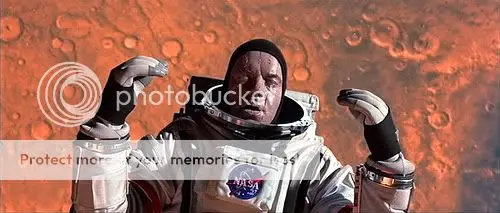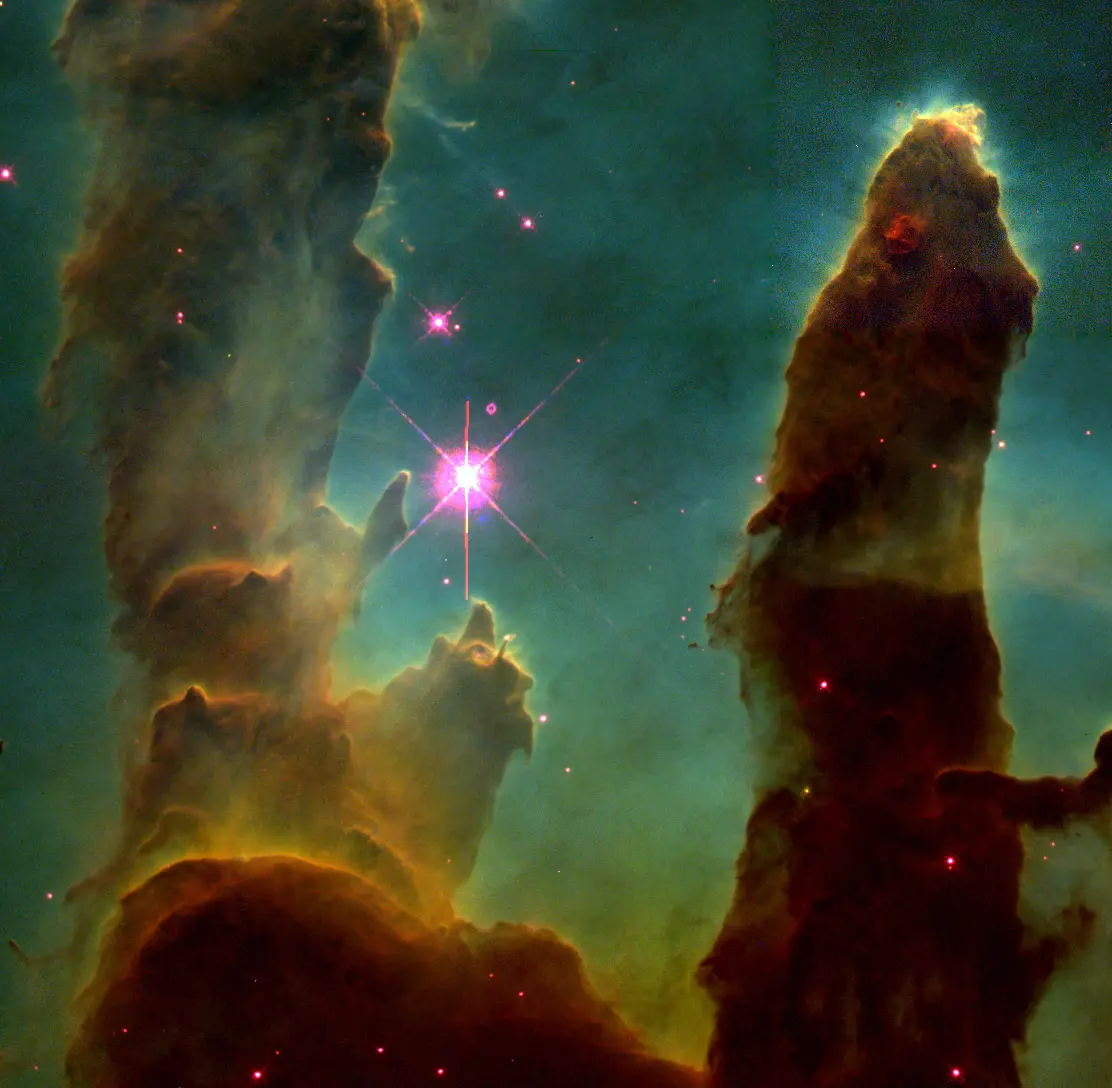Look up. That's space.
Maybe that doesn't floor you quite the same way it does me, but all the same, space has been a mysterious ocean for humanity since we figured out there was something higher up than the sky. Here on Earth, we're tethered and limited, and have explored almost everywhere that was once secret. But space? That will always be a place worth investigating.
Even though humans have successfully been in and out of space, it still holds a lot of mystery for us. Since most of us don't ever get to see it or experience it directly, space also tends to be one of the most confusing environments for fiction writers, and is replete with tropes that many of us (myself included) have been totally willing to accept out of naïveté.
But as you may have noticed, space is getting closer. In fact, many of you might be writing books today that will eventually be published on other planets. We're becoming more of a space-faring race, and it's not inconceivable that your future audience might have a familiarity with the vacuum that we can't yet imagine. This isn't just about satisfying science nerds; this is about making sure your books are still relevant to even uneducated future generations, who may be as familiar with space travel as we are with automobiles.
What is a Vacuum?
A vacuum is defined as a volume that is empty of all matter. That means no air, no cells, and no fairy dust. Nothing.
It may or may not be important to note that a true vacuum is almost impossible to achieve, but outer space is about as close as you can get. In fact, the only matter you'll find in an apparently empty area of space would be a few random hydrogen atoms. For our purposes, that'll be close enough.
Vacuums are low-pressure systems, so a vacuum cleaner works by creating a lower pressure inside the machine than the outside air. This causes the air from the outside to push up into the machine. You may think of it as "sucking" up the dirt, but from a scientific point of view, there is no such thing as a negative pressure. There is simply high and low pressure, so matter moves from a high pressure to a lower pressure.
Newton's Laws of Motion
If you ever took a beginning physics class, you probably started with problems that didn't account for gravity or air resistance. Lucky for us, there is no air resistance in space, and gravity is probably not a significant factor. When we're working in space, we can apply Newton's laws far more practically than we usually can on a variable-rich Earth environment.
First Law
Objects at rest stay at rest, and objects in motion stay in motion, unless acted upon by an outside force. This can often be difficult to picture in an Earthly environment, because we're constantly surrounded by friction-causing matter. For instance, a ball will stop rolling due to friction from the ground. In space, however, there really is no significant source of friction to slow down a moving object. A ball thrown in space will continue sailing along until it hits something.
How this applies in space: Spaceships do not stop when the engines are turned off. Fuel is primarily used for escaping Earth's atmosphere and making directional or velocity adjustments while already in motion. If a spaceship is headed in a direction that it wants to go at a comfortable speed, it can leave its engines off until it needs to slow down or change direction.
Likewise, a missile that misses its target will eventually hit something, even if it takes a thousand years of floating through space to do it. That also means that a battle between two ships can happen at absolutely huge distances, and the victor would be whoever is better at working the math needed to hit a target too far away to even see.
Second Law
Force is mass multiplied by acceleration (f=ma). Acceleration can be due to gravity (9.8 m/s2 on Earth), but in space, it'll probably be due to an explosion, an engine firing, or something of that sort. All this law says is that a greater force is needed to move a heavier object than a lighter object, and if you wish to increase the speed of an object, you need to apply more force.
How this applies in space: This works pretty much the same way in space that it does on Earth. If your spaceship hits something small (like a random floating hydrogen atom), there will be no notable effect on a spaceship's velocity or direction due to the extremely low force. Hitting a space whale, however, will have a notable effect.
According to the second law, a very tiny object can still have an incredible acceleration and therefore a huge force when it hits something. In fact, micrometeoroids pose a significant threat to real life spacecraft. Despite their small size, they move fast enough to carry a powerful force which can damage a spaceship over time. Check out this picture from damage to the shuttle Atlantis:
Third Law
For every action, there is an equal and opposite reaction. You push a ball, and the ball pushes back on you with an equal force. However, since you're probably not Indiana Jones, you have a larger mass than the ball and therefore (because of the second law above) are more difficult to move. The forces are equal in both directions.
How this applies in space: Well, just ask NASA. Astronaut Gene Cernan was part of the Gemini 9 team and the third man to walk in space. The objective was to see if any real work could be done outside of a spacecraft. However, because NASA engineers apparently forgot about Newton's third law, there were no handrails built onto the ship, so every time Cernan tried to turn a valve, he would be spun by the force of the valve back on him. In fact, even basic movement was so difficult that the space walk was scrapped after his team leader became concerned that Cernan might lose consciousness from the exertion.
And THIS is why you fact check your fiction/space missions before publishing/launching.
Exposed to the Vacuum
Alright, let's assume that your character is caught out in the oppressive vacuum in nothing but his skivvies. What's going to happen?
Pressure
Let's start with the basics. First off, your body is pretty good at keeping your insides inside. That creates a pressure inside of your body, and when you're exposed to the vacuum, that internal pressure is much higher than the outside pressure. Human skin is pretty strong stuff, but under these conditions, exposed areas of the body can swell up and cause intense pain.
It's also because of your skin that your blood does not boil in space. You see, temperature and pressure are very much related, as both refer to the energy of a substance's atoms. When a substance is under a high pressure, this essentially means that the atoms on the inside of the container have a higher energy than those on the outside. So when we boil water, we're not just increasing the temperature, but we're also increasing the pressure.
Now, if you follow that math to its conclusion, you can deduce that by lowering the pressure around a liquid, it will start to boil without having changed temperature. Your blood is under pressure inside your body, and will not experience a high enough pressure differential to begin boiling. Any exposed water, such as is found in your eyes, mouth, and lungs, will boil off pretty quickly. This probably won't do any significant damage, but it will make those parts of your body feel frozen due to the energy the boiling process will sap from your body.
The real danger from loitering in a low-pressure environment are gas bubbles that form in your circulatory system. Although your blood doesn't boil, the water in your blood can turn gaseous in spots and form gas bubbles, which will block circulation. With no circulation, your astronaut likely only has seconds before he goes unconscious. Just as well, any air trapped in the lungs will try to find a way out if the throat isn't open, which can lead to the lungs rupturing. Ouchies!

Radiation
Earth's atmosphere is pretty swell in that it protects us from the incredibly damaging rays of the sun and other cosmic radiation that constantly bombards our planet. Space offers no such protection, so astronauts without protective equipment (such as the unfortunate skivvy-wearing character aforementioned) would be exposed to the entire wrath of space, resulting in sunburn, damage to the DNA, and blindness. This may not kill him immediately, but long-term problems like cancer would be expected.
What if I want my character to survive the vacuum?
It's quite possible to survive short-term exposure in space, so if you want a character to survive and come home to describe the experience of getting up close and personal with the vacuum, here are some suggestions:
- Give your character some warning. A slower depressurization is safer, but if it's too slow, they'll be unconscious or dead before they even hit space. Even a few seconds will allow the character to exhale and for their body to adjust more gradually.
- Make sure the character has exhaled as much as possible before hitting the vacuum. Any leftover air in the lungs will try to find a way out, and if the character tries to inhale and hold his breath, then he's not going to survive.
- Your character will go unconscious in about fifteen seconds due to a ceasing of circulation, so keep that in mind.
- As the liquids in the character's tissues turn to gas, any exposed areas will increase in volume, possibly inflating to over twice their original size.
- They will feel their mouth and throat freeze as any liquids exposed to the vacuum boil away.
- If they are near a star, they will get sunburned.
- If they are too near a star, they will roast.
- They need to be safe and under medical care within about ninety seconds of initial exposure if they can be reasonably expected to survive.
Space Isn't Cold (per se)
Space isn't cold (or hot, for that matter).
While this might surprise you... well, look at the heading. It seems to have been slammed into our heads that space is a cold place that will instantly freeze you solid. In fact, I initially believed this trope because of a scene from Mission to Mars, because apparently I thought Tim Robbins was my science teacher.

The problem comes because people intuitively treat heat as a substance, and it's really not. Heat is the transfer of internal energy from one substance to another. When a bunch of high-energy atoms (like those on a hot grill) come into contact with a group of atoms with lower energy (such as those in your careless hand), the energy moves from the grill to your hand. Likewise, when you touch an ice cube, the energy is moving from your hand to the lower energy of the ice cube. So heat is really just the transfer of energy from one form of matter to another.
Here on Earth (or wherever you're from), we're constantly surrounded by other atoms from the atmosphere, and are constantly either being drained of energy (in cold air) or having our energy increased (by hot air).
In space, however, there is no atmosphere. It is the lack of all matter. Quite simply, there are no other atoms around with which to have a heat transfer at all. In fact, space ships are designed to vent heat that results from all of the electronics running on board (which is why things got so chilly when the power went out on Apollo 13).
So why do we think of space as a cold environment? Well, because things in space do eventually get cold through a process of radiation. Matter can release energy through radiation straight into a vacuum without need for a matter medium, and humans are no exception. Now, the speed of radiation is dependent on a few different factors, but overall it's a slower process than heat transfer. So anything that's left out in space for a while will eventually reach a temperature only slightly above absolute zero, and touching that object will cause a pretty catastrophic heat transfer for your astronaut (atom to atom contact, remember).
But if your astronaut decides to go skinny-dipping in the great cosmic ocean of space, how long he or she survives the temperature depends entirely on how close he or she is to a radiating heat source, such as a star. In any case, they will not automatically freeze. They have more important things to worry about than a coat.
Explosions in Space
Let's take a moment to cover explosions, because any time a story is set in space, there's going to be an explosion at some point. I didn't research that fact. I simply know it.
So what does an explosion actually look like in space? Well, let's start off small and look at how fire burns in the absence of gravity. Here on Earth, air weighs differently depending on its temperature. Hot air rises. This is why flames themselves look like they're rising, since they're burning air as it's floating away. However, in space, hot air is no heavier than cold air, so you end up with an interesting phenomenon where flames burn as spheres.
[video:http://www.youtube.com/watch?v=9zdD7lfB0Fs]
So what would you see? Well, depending on the size of the ship (or, more specifically, how much atmosphere it was carrying), you would see a flash of a spherical light that would disappear very quickly. Then you might see larger pieces of debris. Really, since there's no oxygen around to burn, it would be fairly unimpressive compared to what we usually see in Star Wars. Further, because of this lack of atmosphere, there would be no shockwave, and all your character would hear is the sound of debris hitting his ship.
What Does Space Look Like... In Space?
I don't remember when I first learned that space pictures are tricky, but it was a bit of a bummer. Look at this gorgeous photo of the pillars of the Eagle Nebula, for instance.

You probably already know that almost every colorful picture you see of space is manipulated to show false color. This makes the pictures a bit more pleasing to the eye, but also helps scientists get a better grasp on what they're seeing. Second, each pillar of that nebula is actually several light-years long. At this distance, it looks like a cloud, but it's still pretty close to a vacuum out there. You probably wouldn't even know you were flying through it.
In addition, black holes are invisible and asteroid belts provide absolutely no hazard to even a blind pilot.
But there has to be some sort of visual beauty, right?
Well, you will see stars in space, and they will be beautiful. The moon landing photographs created a common myth that you couldn't see stars once you hit orbit, but the truth is that most stars simply aren't bright enough to pick up in traditional photographs used at the time of the moon landings. They couldn't get stars to expose out there any better than we can take a Polaroid of them down here.
But make no mistake, you have plenty of imagery to work with in space.
[video:https://www.youtube.com/watch?v=RiGeqsGjhoY]
Oh, and don't forget that our own sun is actually white, not yellow. Color is based on the temperature of the star, and many stars actually do emit non-white color which becomes more visible through binoculars. Bad Astronomy has a good article about this if you're interested.
In Conclusion
There are a lot of topics I could cover in space, but I tried to keep us focused on a fairly specific topic of the vacuum, which is why this article is a little shorter than my others. Though this may have limited applicability for any science fiction author who doesn't plan on tossing his or her characters out of an airlock, somebody requested it, and damn if I don't deliver.
I also wanted to take this opportunity to thank you for the support I've received for this column. In addition to any comments about this article, I invite you to leave any suggestions for how I might improve It's Made Of SCIENCE for the future.
Do you have an idea for my next science-themed article? I'm taking suggestions! Drop me some topics in the comments, and if I like it, and feel that I either understand or can research it well enough to explain it, your idea can be the next IMOS article. Also, feel free to call me out if you spot an error anywhere; I'd rather have a perfect article than a reputation for being perfect.

About the author
Nathan Scalia earned a BA degree in psychology and considered medical school long enough to realize that he missed reading real books. He then went on to earn a Master's in Library Science and is currently working in a school library. He has written several new articles and columns for LitReactor, served for a time as the site's Community Manager, and can be found in the Writer's Workshop with some frequency.









